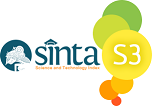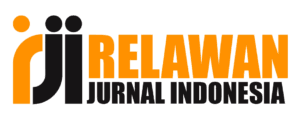EDITORIAL BOARD
About the Journal
Focus and Scope
Sainmatika: Jurnal Ilmiah Matematika dan Ilmu Pengetahuan Alam embodies original research or scientific articles from laboratory or field experiments and also theoretical as well as collaborative research in pure Mathematics, Chemistry, Physics and Biology.
Peer Review Process
Every article that goes to the editorial staff will be selected through Initial Review processes by Editorial Board. Then, the articles will be sent to the Mitra Bebestari/ peer reviewer and will go to the next selection by Blind Preview Process. Only those research articles meeting the Sainmatika focus and scope will be sent to reviewers for review process. After that, the articles will be returned to the authors to revise. These processes take a month for maximum time. In the each manuscript, Mitra Bebestari/ peer reviewer will be rated from the substantial and technical aspects.
Manuscript processing time in Sainmatika: Jurnal Ilmiah Matematika dan Ilmu Pengetahuan Alam:
- The author has 10 days waiting period on the first article submission, the section editor will decide whether the article needs to be revised or not
- Section editor needs 3 days to examine the article based on Sainmatika Journal author guideline
- Author has 14 days to revise the article consistent with the Sainmatika Journal author guideline
- The revised article given to the editor to be reviewed, the editorial team needs maximum of 15 days to finish the review.
- If the article Declined, editor has 3 days to inform the author regarding the editorial team decision
- If the article Revision Required, editorial team will proceed the article to the reviewer
- Reviewer has 30 days to review the article divided into two times review and provide the decision, Accepted or Declined
- The editorial team discusses the final decision in an editorial team meeting whether the articles recommended by the reviewers proceed to be Published or Declined. The editorial team has 20 days to make the final decision.
- The soon-to-be-published articles, lay-outed by the editor for 30 days
- Author has 3 days to confirm the layout result.
- Editor publishes the accepted articles.
Publication Frequency
Sainmatika: Jurnal Ilmiah Matematika dan Imu Pengetahuan Alam journal is published twice a year; in June and December. It is also published in two versions; print out and electronic.
Open Access Policy
This journal provides immediate open access to its content on the principle that making research freely available to the public supports a greater global exchange of knowledge.
Publication Ethics Statement
Sainmatika Journal is a peer-reviewed journal published by Faculty of Science and Technology Universitas PGRI Palembang . This statement clarifies ethical behaviour of all parties involved in the act of publishing an article in this journal, including the author, the chief editor, the Editorial Board, the peer-reviewer and the publisher. This statement is based on COPs Best Practice Guidelines for Journal Editors.
Ethical Guideline for Journal Publication
The publication of an article in a peer-reviewed SAINMATIKA journal is an essential building block in the development of a coherent and respected network of knowledge. It is a direct reflection of the quality of the work of the authors and the institutions that support them. Peer-reviewed articles support and embody the scientific method. It is therefore important to agree upon standards of expected ethical behavior for all parties involved in the act of publishing: the author, the journal editor, the peer reviewer, the publisher and the society.
Publication decisions
The editor of the SAINMATIKA journal is responsible for deciding which of the articles submitted to the journal should be published. The validation of the work in question and its importance to researchers and readers must always drive such decisions. The editors may be guided by the policies of the journal's editorial board and constrained by such legal requirements as shall then be in force regarding libel, copyright infringement and plagiarism. The editors may confer with other editors or reviewers in making this decision.
Fair play
An editor at any time evaluate manuscripts for their intellectual content without regard to race, gender, sexual orientation, religious belief, ethnic origin, citizenship, or political philosophy of the authors.
Confidentiality
The editor and any editorial staff must not disclose any information about a submitted manuscript to anyone other than the corresponding author, reviewers, potential reviewers, other editorial advisers, and the publisher, as appropriate.
Disclosure and conflicts of interest
Unpublished materials disclosed in a submitted manuscript must not be used in an editor's own research without the express written consent of the author.
Duties of Reviewers
Contribution to Editorial DecisionsPeer review assists the editor in making editorial decisions and through the editorial communications with the author may also assist the author in improving the paper.
PromptnessAny selected referee who feels unqualified to review the research reported in a manuscript or knows that its prompt review will be impossible should notify the editor and excuse himself from the review process.
ConfidentialityAny manuscripts received for review must be treated as confidential documents. They must not be shown to or discussed with others except as authorized by the editor.
Standards of ObjectivityReviews should be conducted objectively. Personal criticism of the author is inappropriate. Referees should express their views clearly with supporting arguments.
Acknowledgement of SourcesReviewers should identify relevant published work that has not been cited by the authors. Any statement that an observation, derivation, or argument had been previously reported should be accompanied by the relevant citation. A reviewer should also call to the editor's attention any substantial similarity or overlap between the manuscript under consideration and any other published paper of which they have personal knowledge.
Disclosure and Conflict of InterestPrivileged information or ideas obtained through peer review must be kept confidential and not used for personal advantage. Reviewers should not consider manuscripts in which they have conflicts of interest resulting from competitive, collaborative, or other relationships or connections with any of the authors, companies, or institutions connected to the papers.
Duties of Authors
Reporting standardsAuthors of reports of original research should present an accurate account of the work performed as well as an objective discussion of its significance. Underlying data should be represented accurately in the paper. A paper should contain sufficient detail and references to permit others to replicate the work. Fraudulent or knowingly inaccurate statements constitute unethical behaviour and are unacceptable.
Data Access and RetentionAuthors are asked to provide the raw data in connection with a paper for editorial review, and should be prepared to provide public access to such data (consistent with the ALPSP-STM Statement on Data and Databases), if practicable, and should in any event be prepared to retain such data for a reasonable time after publication.
Originality and PlagiarismThe authors should ensure that they have written entirely original works, and if the authors have used the work and/or words of others that this has been appropriately cited or quoted.
Multiple, Redundant or Concurrent PublicationAn author should not in general publish manuscripts describing essentially the same research in more than one journal or primary publication. Submitting the same manuscript to more than one journal concurrently constitutes unethical publishing behaviour and is unacceptable.
Acknowledgement of SourcesProper acknowledgment of the work of others must always be given. Authors should cite publications that have been influential in determining the nature of the reported work.
Authorship of the PaperAuthorship should be limited to those who have made a significant contribution to the conception, design, execution, or interpretation of the reported study. All those who have made significant contributions should be listed as co-authors. Where there are others who have participated in certain substantive aspects of the research project, they should be acknowledged or listed as contributors. The corresponding author should ensure that all appropriate co-authors and no inappropriate co-authors are included on the paper, and that all co-authors have seen and approved the final version of the paper and have agreed to its submission for publication.
Hazards and Human or Animal SubjectsIf the work involves chemicals, procedures or equipment that have any unusual hazards inherent in their use, the author must clearly identify these in the manuscript.
Disclosure and Conflicts of InterestAll authors should disclose in their manuscript any financial or other substantive conflict of interest that might be construed to influence the results or interpretation of their manuscript. All sources of financial support for the project should be disclosed.
Fundamental errors in published worksWhen an author discovers a significant error or inaccuracy in his/her own published work, it is the author’s obligation to promptly notify the journal editor or publisher and cooperate with the editor to retract or correct the paper.
Plagiarism Policy
The authors should ensure that they have written entirely original works, and if the authors have used the work and/or words of others that this has been appropriately cited or quoted.
Multiple, Redundant or Concurrent Publication. An author should not in general publish manuscripts describing essentially the same research in more than one journal or primary publication. Submitting the same manuscript to more than one journal concurrently constitutes unethical publishing behavior and is unacceptable.
Screening for Plagiarism
All articles submitted to this journal will be checked for plagiarism using Turnitin
Indexing dan Abstracting
Journal History
"Sainmatika: Jurnal Ilmiah Matematika dan Ilmu Pengetahuan Alam" journal publishes articles twice a year in June and December. This journal was firstly published in print version since June 2004 by Faculty of Mathematics and Natural Sciences, Universitas PGRI Palembang with print ISSN 1829-586X. However, archives stored online in this OJS was starting from Volume 6 No. 1 June 2009. Since Volume 14 No. 2 December 2017, this journal has registered with online ISSN 2581-0170 and Sainmatika Journal has been also indexed in SINTA (Science and Technology Index) by Ministry of Higher Education of Indonesia in S3 category. This journal also experienced several times in change of editorial board and reviewers. Starting from Volume 15 No 1 June 2018, the journal template has a slight change such as the addition of journal logo and URL at the first page header of each article and the license logo at the footer. Since volume 18 No. 1, Sainmatika has published 13 articles on each issue.








